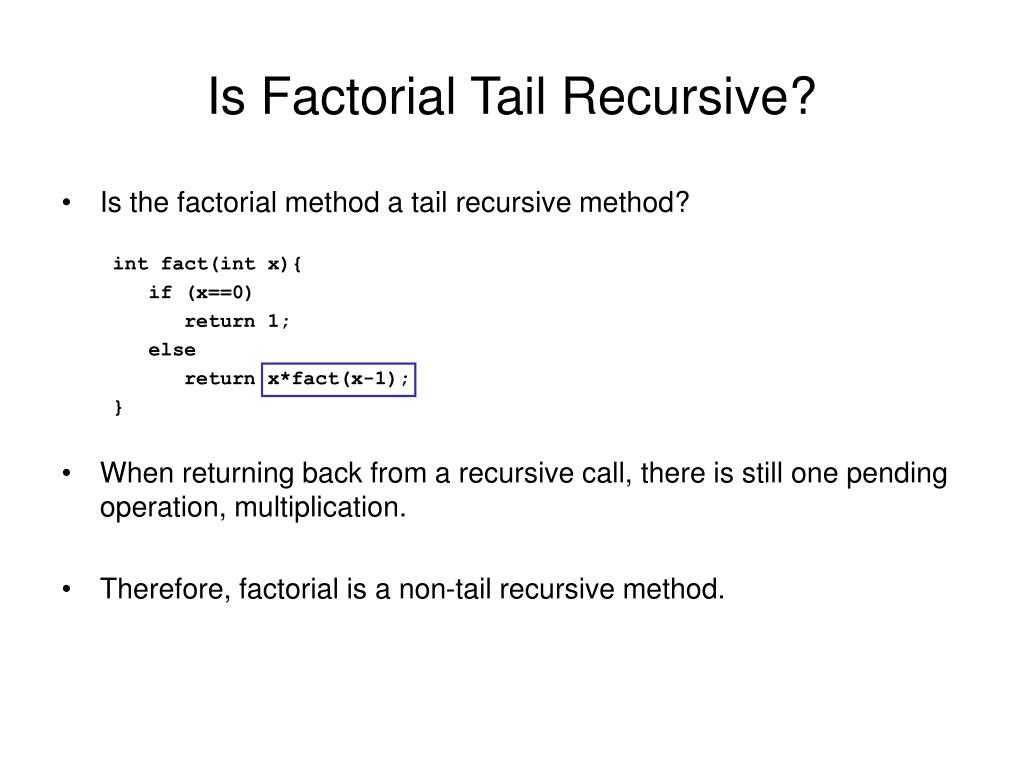
In tail recursion, the processing occurs prior to the recursive call. My answer would be YES, because in head recursion, the recursive call comes before other processing in the function (think of it happening at the top, or head, of the function). Is there any distinction between Recursion and Tail Recursion in Scala? By using tail recursion no need to keep a record of the previous state of the gcd function. Here used for the gcd function that is the tail recursion function. A package import will be used in the programme for the tail recursion function.Įxample of a Tail Recursive Program : import ĭef GCD(n: Int, m: Int): Int def gcd(x:Int, y:Int): Int=.There is no need to keep a record of the previous state. A recursive function is said to be tail-recursive if the recursive call is the last thing done by.Tail-recursive functions outperform non-tail-recursive functions because tail-recursion can be optimised by the compiler.Recursion is a method that split a problem into smaller subproblems and calls itself for each of them.What does Tail Recursion mean in SCALA Language? As if in an implicit accumulator parameter, the list is built as a side effect.However, appending a value to the end of a growing list on exit from a recursive call is equivalent to appending this value to the beginning of the growing list on entry into the recursive call.This call would thus be a tail call except for the cons operation.It applies when the only operation left to perform after a recursive call is to prepend a known value in front of a list returned from it, as the name implies (or to perform a constant number of simple data-constructing operations, in general).Wise described (but did not name) it as a LISP compilation technique in 1974. Warren in the context of a Strongly typed compilation as an explicitly set once language. Tail recursion modulo cons is a generalisation of tail-recursion optimization proposed by David H.The concept behind tail-recursive function optimization is straightforward: since the recursive call is the final statement of the current function, storing the stack frame of the current function serves no purpose.As a result, the stack depth (the greatest amount of stack space used at any one time during compilation) is higher for non-tail recursive functions.Information from a procedure is loaded onto a stack when it is called, and it is removed from the stack when the function is finished. The parameter values for each recursive call are included in this stack along with all other relevant data. Recursive operations are typically carried out by compilers using a stack.Because tail-recursion can be optimised by the compiler, tail-recursive functions are thought to be superior to non-tail-recursive functions.The final process of the function is the multiplication operation (" *"), so the recursion always needs to return to the calling function.Reading Time: 2 minutes What exactly is Tail Recursion?Ī Recursive Function is tail-recursive when the function executes a recursive call. This function is recursive, but not tail recursive. Factorial function without tail recursion


Here is an example of a simple JavaScript factorial function written first without, and then with, tail recursion. Normally, each level of recursion would require an additional return address to be pushed onto the stack. This small optimization becomes more significant when used in a recursive function. It can return the return value of myTailFunc as the return value of myFunc. Essentially, it does not need to push a return address onto the stack, because it doesn't need to return to myFunc. When the compiler sees that it is the final operation of myFunc, it can perform a small optimization. Here, the call to myTailFunc(myVar) is a tail call because it is the last operation of myFunc(myVar). For instance, in this JavaScript program: A tail call is when a function is called as the last act of another function.

In computer programming, tail recursion is the use of a tail call to perform a recursive function.


 0 kommentar(er)
0 kommentar(er)
